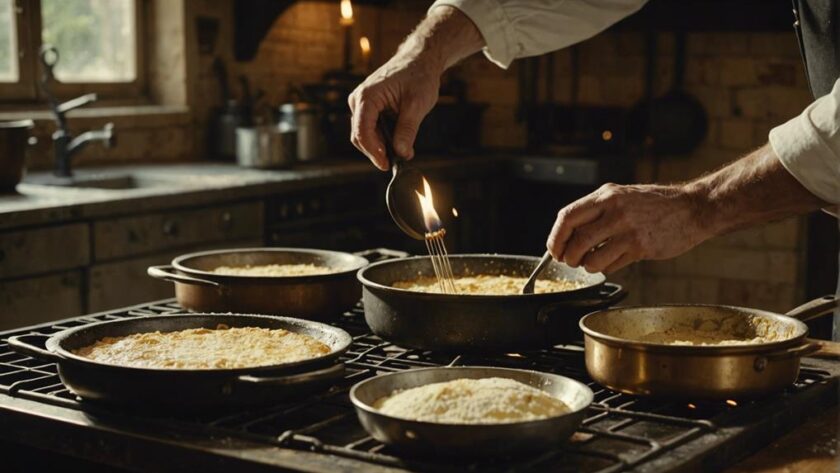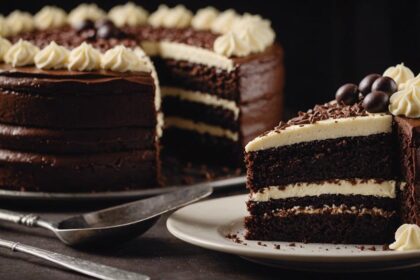Discover the origins of Crème Brûlée, a cherished French dessert dating back to the 17th century. Influenced by historical figures like François Massialot and varied regional cuisines, this delicacy boasts a rich evolution of flavors. The caramelized sugar topping and creamy base create a perfect contrast, enhancing its elegant appeal. Learn how its popularity spread across Europe and witness the modern twists and innovations that have expanded its global presence. Explore the cultural significance and meticulous preparation involved in this sophisticated treat. Uncover the fascinating journey of how Crème Brûlée has become a beloved culinary delight with a timeless allure.
Early History of Crème Brûlée
The origins of Crème Brûlée can be traced back to the early 17th century when the first printed recipe for this delectable French dessert appeared in the cookbook 'Le Cuisinier Royal et Bourgeois' by Cook Francois Massialot from the Palace of Versailles. This marked a significant moment in the history of the crème, as it became documented for the first time, setting the stage for its future popularity and evolution.
Being a French delicacy, Crème Brûlée quickly gained recognition not only in France but also in Spain and England, with each country claiming a part in its creation. The historical roots of this dessert can be seen as far back as the 15th century in England, where a similar dessert existed, hinting at the dessert's long and varied past. Additionally, Spain's medieval version of the dessert, Crema Catalana, adds another layer to the diverse history of Crème Brûlée, showcasing how this beloved treat has evolved and adapted over the centuries.
Influence of François Massialot
You should consider how François Massialot's culinary contributions, impact on French cuisine, and legacy in dessert making have shaped the history of crème brûlée.
His recipe, emphasizing the caramelized sugar topping, set a standard for the dish's preparation and presentation.
Massialot's influence solidified the dessert's place in French culinary history.
Massialot's Culinary Contributions
How did François Massialot's culinary expertise shape the evolution of the classic French dessert, crème brûlée?
As a cook at the Palace of Versailles, Massialot not only authored the first printed recipe for crème brûlée in 1691 but also played a pivotal role in popularizing and standardizing the French version of this decadent treat.
His emphasis on the caramelized sugar topping, giving rise to the dessert's alternative name 'burnt cream,' became a defining characteristic of crème brûlée.
Impact on French Cuisine
What impact did François Massialot's culinary expertise have on French cuisine, particularly in relation to the evolution of crème brûlée?
Massialot's introduction of the first printed recipe for crème brûlée in 1691 had a profound influence on French dessert culture. By showcasing the French version of this delectable dessert, emphasizing the creamy custard base topped with caramelized sugar, Massialot solidified crème brûlée as a popular and iconic sweet treat in France.
His recipe not only established crème brûlée as a staple in fine dining establishments but also contributed to its association with elegance and sophistication in French gastronomy. Thanks to Massialot's culinary innovation, crème brûlée became a symbol of French culinary finesse and continues to be cherished worldwide.
Legacy in Dessert Making
François Massialot's pioneering approach to crafting crème brûlée continues to influence modern dessert making, leaving an indelible mark on the culinary world.
His 1691 recipe, highlighting a creamy custard base with vanilla and caramelized sugar, solidified crème brûlée as a beloved French dessert. Massialot's meticulous instructions set the standard for achieving the perfect balance of textures and flavors in this iconic dish.
Even today, chefs worldwide draw inspiration from his classic recipe, ensuring that Massialot's legacy lives on through the continued appreciation and enjoyment of crème brûlée. His emphasis on quality ingredients and precise techniques has shaped the dessert-making landscape, making crème brûlée a timeless favorite in the domain of sweets.
French Vs. English Origins
When comparing the French and English origins of crème brûlée, distinctions in preparation and historical backgrounds become evident.
The French origins of crème brûlée can be traced back to a 1691 cookbook by François Massialot, where a recipe for the dessert was first documented.
On the other hand, English versions of a similar dessert can be dated back to the 15th century, showcasing an early presence of a comparable dish in English culinary history.
While the French claim to have refined crème brûlée with the addition of caramelized sugar, the English versions may have influenced the development of this delicacy through their own interpretations and adaptations over time.
These differences in preparation methods and historical roots highlight the unique paths taken by the French and English in the evolution of crème brûlée, showcasing how variations in culinary traditions can shape the development of a beloved dessert.
Spanish Connection to Crème Brûlée
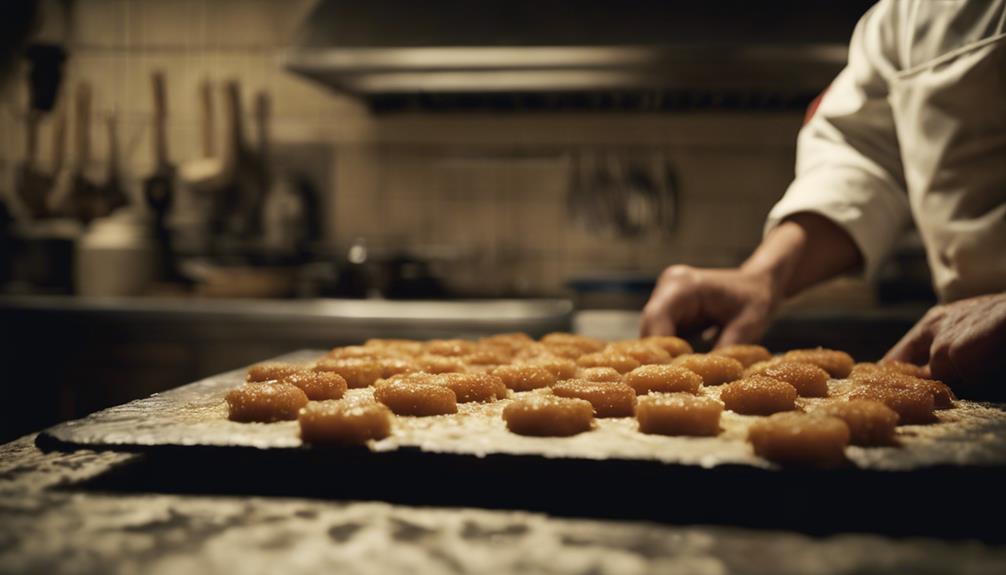
The Spanish connection to crème brûlée sheds light on a medieval dessert known as Crema Catalana, revealing intriguing similarities and historical depth to this beloved treat. Crema Catalana, a custard-based dessert, predates the French version of crème brûlée, adding complexity to the dessert's history. This Spanish delicacy features a caramelized sugar top, reminiscent of the burnt sugar topping found in the French counterpart. The tradition of caramelizing the sugar on top of the custard is a shared characteristic that links the two desserts together.
The roots of Crema Catalana showcase a longstanding tradition of custard-based treats in medieval Spain, highlighting the culinary diversity and influences that have shaped the development of crème brûlée. The Spanish influence on crème brûlée adds a layer of historical significance and cultural exchange to this decadent dessert. The similarities between Crema Catalana and crème brûlée emphasize the interconnectedness of culinary traditions across different regions.
Evolution of Traditional Ingredients
You can explore how traditional crème brûlée ingredients have evolved over time, adapting to new culinary trends and flavors.
From ingredient variations to modern twists on classics, the evolution of traditional ingredients offers a glimpse into the creativity and innovation within the domain of dessert making.
Regional ingredient influences have also played a significant role in shaping the diverse flavors and textures found in different versions of this beloved French dessert.
Ingredient Variations Over Time
Exploring the evolution of traditional ingredients in Crème Brûlée reveals a rich tapestry of culinary creativity and innovation. Originally, this classic French dessert consisted of a luscious custard base made with egg yolks, heavy cream, sugar, and vanilla, topped with a caramelized sugar crust.
Over time, chefs have pushed the boundaries by incorporating unique flavors into the custard, such as lavender, coconut, and key lime, adding a modern twist to the traditional recipe. These variations have expanded the dessert's appeal, catering to diverse taste preferences and reflecting current culinary trends.
The evolution of ingredients in crème brûlée showcases its adaptability and versatility, ensuring its enduring popularity in the ever-evolving world of desserts.
Modern Twists on Classics
Incorporating innovative ingredient substitutions and creative flavor combinations has become a hallmark of modern twists on classic crème brûlée recipes. Chefs are exploring alternative dairy products like coconut milk or almond milk to cater to vegan preferences. You might come across unique flavors such as lavender, matcha, or chai spices in modern adaptations, elevating the traditional dessert to new heights.
Experimentation with unconventional toppings like toasted nuts, fruit compotes, or edible flowers adds a contemporary touch to the classic dish. The evolution of traditional ingredients in crème brûlée reflects a culinary trend towards customization and exploration of diverse flavor profiles.
If you're looking to try these modern twists, a cookbook featuring these innovative recipes could be a great starting point to expand your culinary repertoire.
Regional Ingredient Influences
The evolution of traditional ingredients in crème brûlée has been influenced by regional flavors, leading to a variety of unique adaptations and flavor combinations. While the classic recipe includes cream, eggs, sugar, and vanilla, regional influences have sparked creative variations incorporating ingredients like lavender, coconut, key lime, and butterscotch.
Modern twists on this French delicacy feature unconventional flavors such as chocolate, banana, and pumpkin, offering a departure from the traditional elements. Experimentation with ingredients has given rise to diverse interpretations like white chocolate, tuxedo, and salted butterscotch crème brûlée, showcasing the versatility of this dessert.
The incorporation of different ingredients adds depth and complexity to the traditional crème brûlée, appealing to a wide range of taste preferences.
The Rise of Caramelized Sugar Topping
During the 17th century in France, the technique of caramelizing sugar on top of crème brûlée gained popularity for its contrasting texture and flavor. The burnt sugar topping, achieved by using a kitchen blowtorch or broiler, creates a crispy layer that beautifully complements the creamy custard base of the dessert. This method of caramelization not only adds a delightful crunch but also enhances the overall sensory experience of crème brûlée.
The crackly sugar crust that forms after torching the sugar became a defining feature of crème brûlée's appeal. The contrast between the smooth custard and the caramelized sugar topping is what makes this French delicacy so beloved and iconic. The process of caramelizing the sugar on top adds a touch of sophistication and elegance to the dessert, elevating it from a simple custard to a culinary masterpiece. As a result, the rise of caramelized sugar topping contributed significantly to the enduring popularity of crème brûlée.
Popularization in 17th Century France
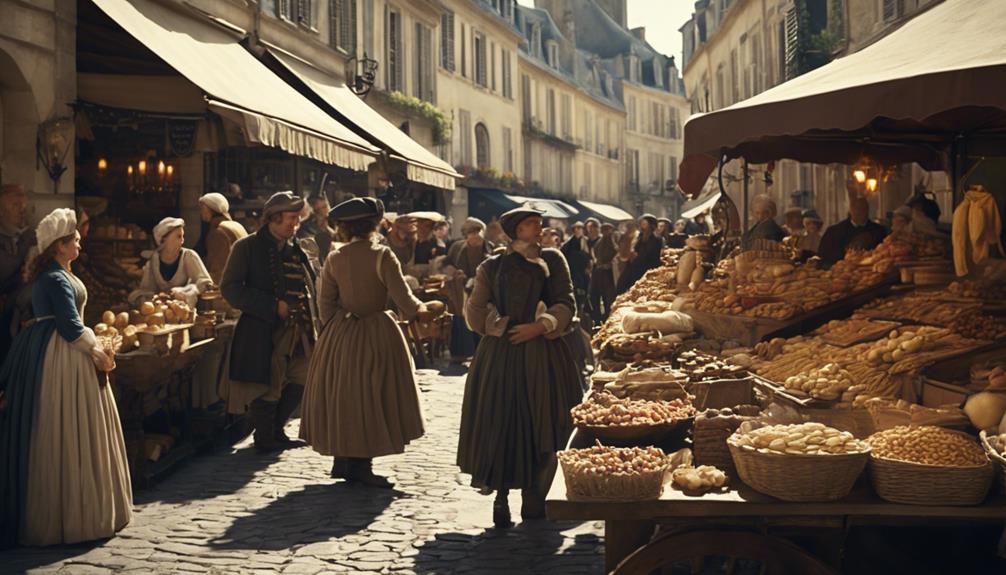
By the 17th century, crème brûlée had become a popular dessert in France, especially among the elite at the royal court.
It was a culinary trendsetter, with its creamy custard base and caramelized sugar topping enchanting the palates of high society.
The French adaptation of crème brûlée marked a significant influence on the dessert scene of that time.
17th Century Influence
Amidst the culinary evolution of 17th century France, crème brûlée emerged as a decadent dessert, capturing the palates of the elite and setting trends in high society dining. French cookbooks of the era, such as Le Cuisinier Royal et Bourgeois by Francois, featured recipes for this exquisite treat.
The distinctive caramelized sugar disks adorning rich custard became a signature element of crème brûlée, elevating it to a coveted delicacy. The 17th century witnessed a surge in experimentation with custard dishes, with crème brûlée standing out as a beloved choice among the upper echelons of society.
Its allure extended to fine dining establishments, where it became a staple on dessert menus, solidifying its status as a timeless classic.
Royal Court Dessert
Emerging as a decadent dessert in 17th century France, crème brûlée gained popularity as a royal court delicacy, enchanting the aristocracy with its rich texture and caramelized sugar topping.
This luxurious treat was prominently featured in François Massialot's 1691 cookbook, 'Le Cuisinier Royal et Bourgeois.' The combination of smooth cream and the satisfying crunch of burnt sugar delighted the palates of the French nobility, becoming a symbol of opulence and refinement.
Its association with the royal courts solidified crème brûlée's status as a dessert fit for the elite, further propelling its fame across the country.
Culinary Trendsetter
During the 17th century in France, crème brûlée became a culinary trendsetter, delighting palates with its decadent cream and caramelized sugar combination.
This exquisite dessert, popularized in French cookbooks of the era, featured a unique technique where a burnt sugar disk was used to top the creamy custard.
French cook François Massialot, known for his contributions to culinary arts, prominently included crème brûlée in his famous cookbook 'Cuisinier Royal et Bourgeois.'
The dessert gained recognition for its rich flavors and the innovative method of being burnt with a hot iron or fire to create the signature caramelized crust.
The 17th century marked a significant period for crème brûlée's evolution into a beloved French delicacy.
Spread of Crème Brûlée Across Europe
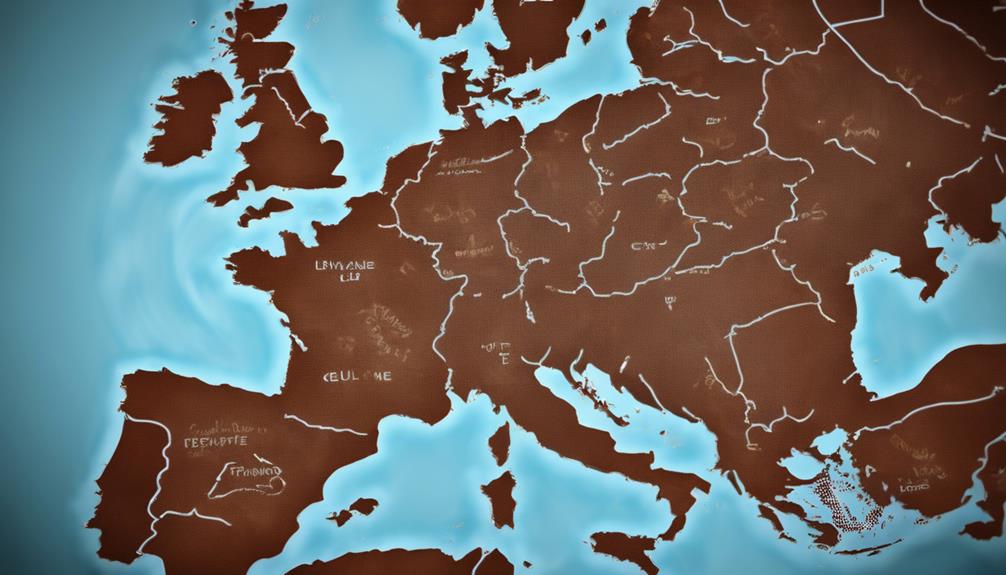
Crème Brûlée's journey across Europe was facilitated by cultural exchanges and royal courts, leading to its widespread popularity in various countries. As this delectable dessert made its way beyond French borders, it found its place on the tables of different European nations, each adding its unique twist to the classic recipe.
- England: The English embraced crème brûlée, with variations emerging in their culinary scene, incorporating local ingredients and techniques.
- Spain: Across the Pyrenees, Spain put its own spin on crème brûlée, infusing it with traditional Spanish flavors and flair.
- Italy: In Italy, the dessert found a home among gelato and tiramisu, enriching the country's diverse dessert offerings.
- Germany: Even in Germany, crème brûlée found a place at the table, adapting to the German sweet tooth and culinary preferences.
The dessert's ability to adapt to different cultural palates contributed to its widespread appreciation and status as a beloved European delicacy.
Modern Variations and Innovations
Modern variations and innovations in the world of crème brûlée have sparked culinary creativity and expanded the dessert's appeal to diverse palates. Chefs have pushed boundaries by introducing unique twists to the traditional egg custard base, such as lavender-infused and pumpkin-flavored versions. These contemporary adaptations often involve the use of a water bath during baking to guarantee a smooth and creamy texture.
Additionally, innovative flavors like salted butterscotch and tuxedo crème brûlée have gained popularity for catering to different taste preferences, offering a delightful contrast of sweet and savory notes. For those with dietary restrictions, vegan options like banana crème brûlée have emerged, showcasing inclusivity and culinary ingenuity.
Indulgent variations like chocolate crème brûlée, which combines dark chocolate with the classic custard, provide a rich and decadent experience. For a tropical twist, coconut crème brûlée offers an invigorating and exotic take on the beloved dessert, appealing to those seeking a unique culinary experience. With sugar on top caramelized to perfection, these modern innovations continue to redefine the boundaries of traditional crème brûlée.
Cultural Significance of Crème Brûlée
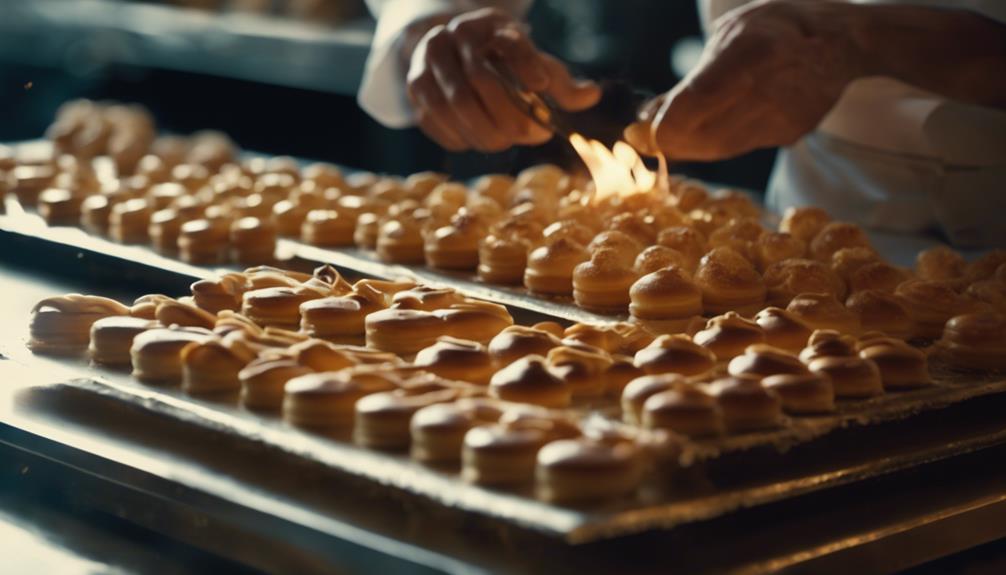
With its roots deeply embedded in French culinary tradition, crème brûlée embodies elegance and luxury, symbolizing a delightful marriage of creamy custard and caramelized sugar. This classic French dessert holds great cultural significance, serving as a representation of the sophistication and artistry of French cuisine. Here are some key points that highlight the cultural importance of crème brûlée:
- Bourgeois by Francois Massialot: Crème brûlée was first mentioned in the cookbook 'Le Cuisinier Royal et Bourgeois' by Francois Massialot in the late 17th century, solidifying its place in French culinary history.
- Luxurious Associations: The dessert's creamy texture and the contrast of the crispy caramelized brown sugar topping have made it a symbol of luxury and refinement, often featured on upscale restaurant menus worldwide.
- Elegance in Presentation: The meticulous preparation and elegant presentation of crème brûlée reflect the attention to detail and sophistication that are characteristic of French gastronomy.
- Global Appeal: Despite its French origins, crème brûlée has gained popularity globally, becoming a beloved dessert enjoyed by people from diverse cultural backgrounds.
Conclusion
You've now uncovered the rich history of crème brûlée, from its early origins to its modern variations.
As you savor this French delicacy, remember the saying 'old is gold' – a reminder that the classics never go out of style.
So, next time you indulge in a creamy, caramelized bite of crème brûlée, appreciate the centuries of tradition and innovation that have gone into perfecting this beloved dessert.
Bon appétit!

